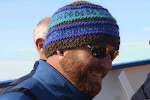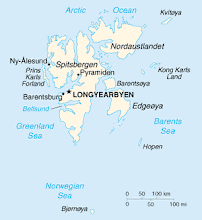Watch this beautiful video created by talented friend, Jason Roberts. He's most famous for shooting footage with David Attenborough's Lonely Planet and Blue Planet specials, and many more.
Jason lives in Longyearbyen and shot this footage for a Phillips advertisement, an experiment in creating simulated daylight for the four months of total darkness in the northernmost city in the world.
Longyearbyen is on Svalbard.
Go HERE to see Jason's work.
Tuesday, October 19, 2010
Sunday, October 17, 2010




New photos, just in, from friends who worked the Arctic this season.
Below, the Akademik Shokalskiy in front of a glacier.
Below, the Akademik Shokalskiy in front of a glacier.
 Large 'sad' polar bear.
Large 'sad' polar bear.This far from the ice it's doubtful he'll find food.
The bearded seals are the main fare and it's likely
the ice is a good 500 miles North,
too far for this weakened bear to swim.
Sunday, October 3, 2010
Friday, September 25, 2009
MORE GURL POWER
Freya Hoffmeister is about to become the first woman to solo circumnavigate Australia. She's trying to beat the record of the only 3 people who've ever done it before, all men.
She's not someone you forget easily. She's an amazingly accomplished kayaker with a varied background, starting out as a model. With a height of 6' tall and always dressed in black, she's a striking figure with a larger-than-life personality.
Check out a profile here about her, then check out her web page.
Follow Freya on the homestretch as she paddles through some of the worst seas in all of Australia.
Phew.
She's not someone you forget easily. She's an amazingly accomplished kayaker with a varied background, starting out as a model. With a height of 6' tall and always dressed in black, she's a striking figure with a larger-than-life personality.
Check out a profile here about her, then check out her web page.
Follow Freya on the homestretch as she paddles through some of the worst seas in all of Australia.
Phew.
Friday, September 18, 2009
SVALBARD, SUMMER 2009
Two dead polar bear cubs found on Svalbard summer 2009. See these and other outstanding photos of the archipelago here.
Tuesday, October 28, 2008
IN THE ICE
On the search for polar bear. First we had to get to the ice. Earlier in the season the ice was thick in the north, reaching all the way down to the north of Svalbard, not permitting us to pass over 80degrees. On the next trips mid-season we were able to travel further north and into the ice as it broke up. There we searched and scanned for hours on end. The sun was getting closer to the horizon.

It never goes below the horizon, but looks like this through much of the 'night.'

Finally, we saw signs.


Then...


These are happy bears, well fed and in the ice where seal is plentiful.

Mother and cub.


Later on, a disturbing and chilling sight, a rare encounter with polar bear cannibalism. Even the long time naturalists had only heard of this yet never seen it. A polar bear eating one of its own is a desperate bear. Polar bears eat blubber. Yet a lean polar bear will not have much blubber on it. We could tell the head had been eaten in back, where the fatty brain is. Here, it's eating a small layer of fat in the lower belly.

This was the sight I feared most, a very lean and lethargic bear, too far south of the ice to ever catch up to find food. It had eaten a small pile of rotting blubber, from a beached whale going back two years. They'll eat anything to fill their bellies, rotting or otherwise. Generally their metabolism slows down to conserve energy. At this stage the ice was about 200 miles north, too far for the bear to swim to catch up to the ice. I called this the Sad Bear. It barely moved the whole time we watched it. Skinny, lethargic, weak and dirty, it most likely didn't make it.

Too close for comfort! Who was more surprised, Phil or the massive male just emerged from the water?! Phil held his ground without threatening or retreating and eventually the male edged back into the water. They can and do, do terrible damage to our zodiacs with their tusks should we get too close. We don't even put zodiacs in the water when near walrus beaches.

It never goes below the horizon, but looks like this through much of the 'night.'

Finally, we saw signs.


Then...


These are happy bears, well fed and in the ice where seal is plentiful.

Mother and cub.


Later on, a disturbing and chilling sight, a rare encounter with polar bear cannibalism. Even the long time naturalists had only heard of this yet never seen it. A polar bear eating one of its own is a desperate bear. Polar bears eat blubber. Yet a lean polar bear will not have much blubber on it. We could tell the head had been eaten in back, where the fatty brain is. Here, it's eating a small layer of fat in the lower belly.

This was the sight I feared most, a very lean and lethargic bear, too far south of the ice to ever catch up to find food. It had eaten a small pile of rotting blubber, from a beached whale going back two years. They'll eat anything to fill their bellies, rotting or otherwise. Generally their metabolism slows down to conserve energy. At this stage the ice was about 200 miles north, too far for the bear to swim to catch up to the ice. I called this the Sad Bear. It barely moved the whole time we watched it. Skinny, lethargic, weak and dirty, it most likely didn't make it.

Too close for comfort! Who was more surprised, Phil or the massive male just emerged from the water?! Phil held his ground without threatening or retreating and eventually the male edged back into the water. They can and do, do terrible damage to our zodiacs with their tusks should we get too close. We don't even put zodiacs in the water when near walrus beaches.
GORGEOUS ICEBERGS

This massive iceberg is typical of those that break off ice shelves and float around in the currents for several years, breaking up as time passes. This one is most likely from Greenland.
Below, these smaller pieces called bergy bits are ever present and choke some channels. We can safely navigate between the smaller ones while in kayaks. We generally give them a wide berth while attempting to envision the amount of ice underwater. Should one break apart we want to be out of range as it rebalances.

Melting glacier face in the foggy mist one morning as we climbed nearby.

Below, a rare sighting of an immature kittiwake...they lose all this beautiful plumage at maturity, looking like an ordinary gull with wing tips dipped in ink.
A zodiac provides scale in this immense landscape.
Why we don't go into the glacier's caves!

Or anywhere closer, for that matter.

Just another gorgeous ice berg on an otherwise ordinary day.
Well fed bearded seal. They live on their fat stores through the winter, looking leaner by spring.

Death of a glacier. The ice surrounding the glacier has all melted off. This glacier is shrinking from the sides inward. Eventually it will look smaller and narrower. The debris locked inside will be more visible as the ice around it melts.


It will shrink back from the water's edge.

Until it looks like this.

Not too far distant all the glaciers in Greenland will have receded.


It will shrink back from the water's edge.

Until it looks like this.

Not too far distant all the glaciers in Greenland will have receded.
This bear is most likely overheated from swimming so far to get to the ice. It may or may not have had a meal. But once it's caught up to the ice a meal will never be too far away. This is a cooling off method. A snooze is always in order.
Subscribe to:
Posts (Atom)































